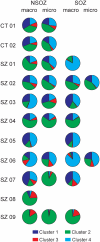Data mining neocortical high-frequency oscillations in epilepsy and controls
- PMID: 21903727
- PMCID: PMC3187540
- DOI: 10.1093/brain/awr212
Data mining neocortical high-frequency oscillations in epilepsy and controls
Abstract
Transient high-frequency (100-500 Hz) oscillations of the local field potential have been studied extensively in human mesial temporal lobe. Previous studies report that both ripple (100-250 Hz) and fast ripple (250-500 Hz) oscillations are increased in the seizure-onset zone of patients with mesial temporal lobe epilepsy. Comparatively little is known, however, about their spatial distribution with respect to seizure-onset zone in neocortical epilepsy, or their prevalence in normal brain. We present a quantitative analysis of high-frequency oscillations and their rates of occurrence in a group of nine patients with neocortical epilepsy and two control patients with no history of seizures. Oscillations were automatically detected and classified using an unsupervised approach in a data set of unprecedented volume in epilepsy research, over 12 terabytes of continuous long-term micro- and macro-electrode intracranial recordings, without human preprocessing, enabling selection-bias-free estimates of oscillation rates. There are three main results: (i) a cluster of ripple frequency oscillations with median spectral centroid = 137 Hz is increased in the seizure-onset zone more frequently than a cluster of fast ripple frequency oscillations (median spectral centroid = 305 Hz); (ii) we found no difference in the rates of high frequency oscillations in control neocortex and the non-seizure-onset zone neocortex of patients with epilepsy, despite the possibility of different underlying mechanisms of generation; and (iii) while previous studies have demonstrated that oscillations recorded by parenchyma-penetrating micro-electrodes have higher peak 100-500 Hz frequencies than penetrating macro-electrodes, this was not found for the epipial electrodes used here to record from the neocortical surface. We conclude that the relative rate of ripple frequency oscillations is a potential biomarker for epileptic neocortex, but that larger prospective studies correlating high-frequency oscillations rates with seizure-onset zone, resected tissue and surgical outcome are required to determine the true predictive value.
Figures




References
-
- Aubert S, Wendling F, Regis J, McGonigal A, Figarella-Branger D, Peragut J-C, et al. Local and remote epileptogenicity in focal cortical dysplasias and neurodevelopmental tumours. Brain. 2009;132:3072–86. - PubMed
-
- Bartolomei F, Chauvel P, Wendling F. Epileptogenicity of brain structures in human temporal lobe epilepsy: a quantified study from intracerebral EEG. Brain. 2008;131(Pt 7):1818–30. - PubMed
-
- Bien CG, Szinay M, Wagner J, Clusmann H, Becker AJ, Urbach H. Characteristics and surgical outcomes of patients with refractory magnetic resonance imaging–negative epilepsies. Arch Neurol. 2009;66:1491–9. - PubMed
Publication types
MeSH terms
Grants and funding
LinkOut - more resources
Full Text Sources
Other Literature Sources
Medical

